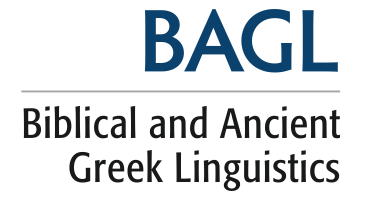[First posted in AWOL 25 July 2016, updated 25 January 2018]
Biblical and Ancient Greek Linguistics (BAGL)
Biblical and Ancient Greek Linguistics (BAGL)
Biblical and Ancient Greek Linguistics (BAGL), in conjunction with the Centre for Biblical Linguistics, Translation, and Exegesis at McMaster Divinity College and the OpenText.org project (www.opentext.org) is a fully refereed on-line and print journal specializing in widely disseminating the latest advances in linguistic study of ancient and biblical Greek. Under the senior editorship of Professor Dr. Stanley E. Porter and Dr. Matthew Brook O'Donnell, along with its assistant editors and editorial board, BAGL looks to publish significant work that advances knowledge of ancient Greek through the utilization of modern linguistic methods. Accepted pieces are in the first instance posted on-line in page-consistent pdf format, and then (except for reviews) are published in print form each volume year. This format ensures timely posting of the most recent work in Greek linguistics with consistently referencable articles then available in permanent print form.
Volume 6 (2017)Show table of contents
Arizona Christian University, Phoenix, AZ, USAThis article responds to the article by Madison Pierce and Benjamin Reynolds on the use of the perfect tense-form in John 3:13. While we commend their treatment of verbal aspect in their analysis, we offer several points of correction on several issues, including the semantics of the perfect tense-form, the use of the aorist participle, and the conditional clause.Keywords: Greek tense-form, perfect tense-form, stative aspect, aorist articular participle, conditional clause
Volume 5 (2016)Show table of contents
Volume 4 (2015)Show table of contents
Volume 3 (2014)Show table of contents
Volume 2 (2013)Show table of contents
Volume 1 (2012)Show table of contents
See AWOL's full List of Open Access Journals in Ancient Studies















